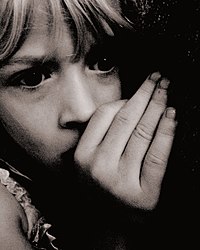
Emerging atypical connectivity networks for processing angry and fearful faces in very preterm born children
Sign Up to like & getrecommendations! Published in 2020 at "Human Brain Mapping"
DOI: 10.1002/hbm.25088
Abstract: Abstract Very preterm born (VPT) children are those born before 32/40 weeks' gestational age and comprise 10% of the 15 million babies born prematurely worldwide each year. Due to advancements in neonatal medicine, the survival rate… read more here.
Keywords: preterm born; fearful faces; born children; connectivity ... See more keywords

Neural and computational processes of accelerated perceptual awareness and decisions: A 7T fMRI study.
Sign Up to like & getrecommendations! Published in 2022 at "Human brain mapping"
DOI: 10.1002/hbm.25889
Abstract: Rapidly detecting salient information in our environments is critical for survival. Visual processing in subcortical areas like the pulvinar and amygdala has been shown to facilitate unconscious processing of salient stimuli. It is unknown, however,… read more here.
Keywords: awareness; fearful faces; neutral faces; perceptual awareness ... See more keywords

Transcutaneous vagus nerve stimulation does not affect attention to fearful faces in high worriers.
Sign Up to like & getrecommendations! Published in 2019 at "Behaviour research and therapy"
DOI: 10.1016/j.brat.2018.12.009
Abstract: People suffering from chronic worries pay excessive attention to emotional information. In this study we examined whether a reduced ability to inhibit attention from fearful faces (i.e. inhibition of return; IOR) can be attributed to… read more here.
Keywords: high worriers; stimulation; fearful faces; vagus nerve ... See more keywords

Attention is prioritised for proximate and approaching fearful faces
Sign Up to like & getrecommendations! Published in 2021 at "Cortex"
DOI: 10.1016/j.cortex.2020.10.011
Abstract: Attention is an important function that allows us to selectively enhance the processing of relevant stimuli in our environment. Fittingly, a number of studies have revealed that potentially threatening/fearful stimuli capture attention more efficiently. Interestingly,… read more here.
Keywords: prioritised proximate; distance; fearful faces; attention prioritised ... See more keywords

Unseen fearful faces facilitate visual discrimination in the intact field
Sign Up to like & getrecommendations! Published in 2019 at "Neuropsychologia"
DOI: 10.1016/j.neuropsychologia.2017.07.029
Abstract: Implicit visual processing of emotional stimuli has been widely investigated since the classical studies on affective blindsight, in which patients with primary visual cortex lesions showed discriminatory abilities for unseen emotional stimuli in the absence… read more here.
Keywords: intact field; blind field; field; fearful faces ... See more keywords

Time course of influence on the allocation of attentional resources caused by unconscious fearful faces
Sign Up to like & getrecommendations! Published in 2018 at "Neuropsychologia"
DOI: 10.1016/j.neuropsychologia.2018.04.001
Abstract: ABSTRACT Emotionally affective stimuli have priority in our visual processing even in the absence of conscious processing. However, the influence of unconscious emotional stimuli on our attentional resources remains unclear. Using the continuous flash suppression… read more here.
Keywords: time course; fearful faces; attentional resources; unconscious fearful ... See more keywords

Specific amygdala response to masked fearful faces in post-traumatic stress relative to other anxiety disorders
Sign Up to like & getrecommendations! Published in 2017 at "Psychological Medicine"
DOI: 10.1017/s0033291717002513
Abstract: Abstract Background Altered amygdala activation to fear-related stimuli has been proposed to be a potential neural correlate of heightened threat sensitivity in anxiety- and stress-related disorders. However, the role of stimulus awareness and disorder specificity… read more here.
Keywords: post traumatic; anxiety; fearful faces; neutral faces ... See more keywords

Infants aren't biased toward fearful faces
Sign Up to like & getrecommendations! Published in 2023 at "Behavioral and Brain Sciences"
DOI: 10.1017/s0140525x2200200x
Abstract: Abstract Grossmann's argument for the “fearful ape hypothesis” rests on an incomplete review of infant responses to emotional faces. An alternate interpretation of the literature argues the opposite, that an early preference for happy faces… read more here.
Keywords: toward fearful; infants biased; biased toward; fearful faces ... See more keywords

Fearful faces straight ahead or in the periphery: Early neuronal responses independently of trait anxiety.
Sign Up to like & getrecommendations! Published in 2022 at "Emotion"
DOI: 10.1037/emo0001184
Abstract: For humans, it is vitally important to rapidly detect potentially threatening stimuli such as fearful faces in the periphery. Trait anxiety has been related to biased responses to threatening faces, which might be more pronounced… read more here.
Keywords: spatial location; trait anxiety; fearful faces;

Associations between hypomania proneness and attentional bias to happy, but not angry or fearful, faces in emerging adults
Sign Up to like & getrecommendations! Published in 2020 at "Cognition and Emotion"
DOI: 10.1080/02699931.2020.1810638
Abstract: ABSTRACT Mania, the core feature of bipolar disorder, is associated with heightened and positive emotion responding. Yet, little is known about the underlying cognitive processes that may contribute to heightened positive emotionality observed. Additionally, while… read more here.
Keywords: emerging adults; attentional bias; fearful faces; happy angry ... See more keywords

More than meets the heart: systolic amplification of different emotional faces is task dependent
Sign Up to like & getrecommendations! Published in 2020 at "Cognition and Emotion"
DOI: 10.1080/02699931.2020.1832050
Abstract: ABSTRACT Interoceptive processes emanating from baroreceptor signals support emotional functioning. Previous research suggests a unique link to fear: fearful faces, presented in synchrony with systolic baroreceptor firing draw more attention and are rated as more… read more here.
Keywords: task; heart systolic; fearful faces; visual search ... See more keywords